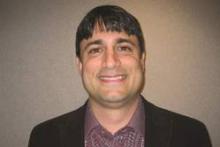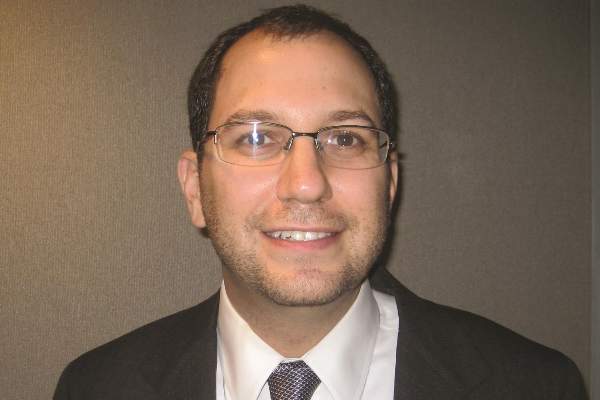User login
SEATTLE– Two sets of simple clinical factors can help physicians identify which critically ill children with brain conditions are at highest risk for subclinical seizures and therefore most likely to benefit from continuous electroencephalographic (EEG) monitoring, according to a pair of studies reported at the annual meeting of the American Epilepsy Society.
Up to a third of patients with brain conditions in critical care units have seizures that are clinically silent, evident only on an EEG, Dr. Nicholas S. Abend, an assistant professor of neurology and pediatrics at the Children’s Hospital of Philadelphia, commented in a press briefing.
“There are more and more data that these seizures are associated with worse outcomes for patients – worse functional outcomes, lower quality of life later, and a higher risk for later epilepsy. And that’s led to a lot of interest in trying to monitor more and more patients in order to identify these seizures and treatment to manage them,” he said. But many hospitals have limited equipment and staff for continuous EEG monitoring and therefore face tough decisions in allocating these resources.
In the first study, Dr. Abend and his colleagues developed and validated a model to predict electrographic seizures in critically ill children with acute encephalopathic conditions.
They developed the model using retrospectively collected data from 336 consecutive children at multiple centers participating in the Critical Care EEG Monitoring Research Consortium. They then validated the model using prospectively collected data from 222 children at a single center, the Children’s Hospital of Philadelphia. Overall, about a third of the children had subclinical seizures.
“When we looked at predictors of seizures, we tried to keep it to things that a clinician would know pretty easily right on admission – not detailed data that might not be available until way later because they usually have to decide at the beginning, ‘Am I going to do EEG monitoring?’ ” Dr. Abend explained. The final model thus had five basic factors: age, etiology, clinically evident seizures before continuous EEG monitoring, initial EEG background pattern, and interictal epileptiform discharges.
Results presented in a poster session showed that the model had an area under the receiver operating characteristic curve of 0.845 in the development cohort and 0.799 in the validation cohort for identifying children who were experiencing subclinical seizures.
Intensive care units can select a model cutoff value based on the resources they have available for continuous EEG monitoring, noted Dr. Abend, who disclosed that he had no relevant conflicts of interest. “So, a center with very limited resources might decide, we only want to do this for really high-risk patients; a center with lots of resources could decide, we are going to apply things much more broadly, because we have EEG machines and we have EEG readers.”
With a broad model cutoff, for example, centers could go from monitoring all children to monitoring just half, with the trade-off of missing only about 10% of those who are having subclinical seizures. “This is not perfect, but few models of diagnostic tests are perfect,” Dr. Abend commented. “So I’ve taken this as pretty positive, that given the variability of going multicenter to single center with only five pretty basic data points, we can cut the monitoring in half and only miss about 10%.”
“In the next version of this study, with cleaner data and clearer criteria for who is getting included, and maybe including more data points, not just the five variables, we may be able to do a lot better. I think if we could cut the monitoring by half, and miss only 5% of patients, that’s not ideal, but maybe then it’s about developing other strategies to try to catch those 5% more efficiently, or at least giving centers with limited resources a logical approach” for deciding whom to monitor, he added.
In the second study, investigators led by Dr. Rajsekar R. Rajaraman, a pediatric neurology fellow at the University of California, Los Angeles, Medical Center, assessed predictors of early subclinical seizures among children with traumatic brain injury admitted to the pediatric intensive care unit. Early seizures were defined as those occurring within 7 days of the injury.
The investigators identified the predictors in a combined cohort of 135 consecutive children from the UCLA Medical Center and the Children’s Hospital of Colorado, and validated them in a cohort of 44 children from the Children’s Hospital of Philadelphia.
Overall, 12.6% of the development cohort and 31.8% of the validation cohort had subclinical seizures on EEG. “The really worrisome thing about subclinical seizures is that 87.1% of these patients who had subclinical seizures went on to have status epilepticus,” Dr. Rajaraman noted in the press briefing.
In a multivariate analysis, three factors predicted the risk of subclinical seizures: age younger than 2 years (odds ratio for older children, 0.84), abusive head trauma as the mechanism of injury (odds ratio, 7.29), and intradural hematoma on a computed tomography scan (odds ratio could not be calculated because this factor was present in all children with subclinical seizures). Findings were similar for the risk subclinical status epilepticus.
Notably, this set of factors worked similarly well in both the development cohort and the validation cohort, even though the latter had a greater severity of injury.
“All traumatic brain injury patients under the age of 2 [years] with intradural blood on CT should be placed on continuous video EEG,” recommended Dr. Rajaraman, who disclosed that he had no relevant conflicts of interest. “Additionally, if history suggests abusive head trauma, they are even more likely to have subclinical seizures.”
By using these factors to help identify these patients, “we can treat them sooner based on the video EEG monitoring. It’s also more cost-effective and more practical,” he added.
Dr. Jason T. Lerner a pediatric neurologist with UCLA Medical Center and a coinvestigator on the study, noted that the next step is to further test the factors’ validity in a broader population.
“Now we are working with the rest of the [Critical Care EEG Monitoring Research Consortium]. So we know the model works in two centers across the country on different coasts; now we are looking at another dozen different centers to see if this is something that does translate throughout the entire country, then hopefully even the world,” explained Dr. Lerner, who disclosed that he had no relevant conflicts of interest.
SEATTLE– Two sets of simple clinical factors can help physicians identify which critically ill children with brain conditions are at highest risk for subclinical seizures and therefore most likely to benefit from continuous electroencephalographic (EEG) monitoring, according to a pair of studies reported at the annual meeting of the American Epilepsy Society.
Up to a third of patients with brain conditions in critical care units have seizures that are clinically silent, evident only on an EEG, Dr. Nicholas S. Abend, an assistant professor of neurology and pediatrics at the Children’s Hospital of Philadelphia, commented in a press briefing.
“There are more and more data that these seizures are associated with worse outcomes for patients – worse functional outcomes, lower quality of life later, and a higher risk for later epilepsy. And that’s led to a lot of interest in trying to monitor more and more patients in order to identify these seizures and treatment to manage them,” he said. But many hospitals have limited equipment and staff for continuous EEG monitoring and therefore face tough decisions in allocating these resources.
In the first study, Dr. Abend and his colleagues developed and validated a model to predict electrographic seizures in critically ill children with acute encephalopathic conditions.
They developed the model using retrospectively collected data from 336 consecutive children at multiple centers participating in the Critical Care EEG Monitoring Research Consortium. They then validated the model using prospectively collected data from 222 children at a single center, the Children’s Hospital of Philadelphia. Overall, about a third of the children had subclinical seizures.
“When we looked at predictors of seizures, we tried to keep it to things that a clinician would know pretty easily right on admission – not detailed data that might not be available until way later because they usually have to decide at the beginning, ‘Am I going to do EEG monitoring?’ ” Dr. Abend explained. The final model thus had five basic factors: age, etiology, clinically evident seizures before continuous EEG monitoring, initial EEG background pattern, and interictal epileptiform discharges.
Results presented in a poster session showed that the model had an area under the receiver operating characteristic curve of 0.845 in the development cohort and 0.799 in the validation cohort for identifying children who were experiencing subclinical seizures.
Intensive care units can select a model cutoff value based on the resources they have available for continuous EEG monitoring, noted Dr. Abend, who disclosed that he had no relevant conflicts of interest. “So, a center with very limited resources might decide, we only want to do this for really high-risk patients; a center with lots of resources could decide, we are going to apply things much more broadly, because we have EEG machines and we have EEG readers.”
With a broad model cutoff, for example, centers could go from monitoring all children to monitoring just half, with the trade-off of missing only about 10% of those who are having subclinical seizures. “This is not perfect, but few models of diagnostic tests are perfect,” Dr. Abend commented. “So I’ve taken this as pretty positive, that given the variability of going multicenter to single center with only five pretty basic data points, we can cut the monitoring in half and only miss about 10%.”
“In the next version of this study, with cleaner data and clearer criteria for who is getting included, and maybe including more data points, not just the five variables, we may be able to do a lot better. I think if we could cut the monitoring by half, and miss only 5% of patients, that’s not ideal, but maybe then it’s about developing other strategies to try to catch those 5% more efficiently, or at least giving centers with limited resources a logical approach” for deciding whom to monitor, he added.
In the second study, investigators led by Dr. Rajsekar R. Rajaraman, a pediatric neurology fellow at the University of California, Los Angeles, Medical Center, assessed predictors of early subclinical seizures among children with traumatic brain injury admitted to the pediatric intensive care unit. Early seizures were defined as those occurring within 7 days of the injury.
The investigators identified the predictors in a combined cohort of 135 consecutive children from the UCLA Medical Center and the Children’s Hospital of Colorado, and validated them in a cohort of 44 children from the Children’s Hospital of Philadelphia.
Overall, 12.6% of the development cohort and 31.8% of the validation cohort had subclinical seizures on EEG. “The really worrisome thing about subclinical seizures is that 87.1% of these patients who had subclinical seizures went on to have status epilepticus,” Dr. Rajaraman noted in the press briefing.
In a multivariate analysis, three factors predicted the risk of subclinical seizures: age younger than 2 years (odds ratio for older children, 0.84), abusive head trauma as the mechanism of injury (odds ratio, 7.29), and intradural hematoma on a computed tomography scan (odds ratio could not be calculated because this factor was present in all children with subclinical seizures). Findings were similar for the risk subclinical status epilepticus.
Notably, this set of factors worked similarly well in both the development cohort and the validation cohort, even though the latter had a greater severity of injury.
“All traumatic brain injury patients under the age of 2 [years] with intradural blood on CT should be placed on continuous video EEG,” recommended Dr. Rajaraman, who disclosed that he had no relevant conflicts of interest. “Additionally, if history suggests abusive head trauma, they are even more likely to have subclinical seizures.”
By using these factors to help identify these patients, “we can treat them sooner based on the video EEG monitoring. It’s also more cost-effective and more practical,” he added.
Dr. Jason T. Lerner a pediatric neurologist with UCLA Medical Center and a coinvestigator on the study, noted that the next step is to further test the factors’ validity in a broader population.
“Now we are working with the rest of the [Critical Care EEG Monitoring Research Consortium]. So we know the model works in two centers across the country on different coasts; now we are looking at another dozen different centers to see if this is something that does translate throughout the entire country, then hopefully even the world,” explained Dr. Lerner, who disclosed that he had no relevant conflicts of interest.
SEATTLE– Two sets of simple clinical factors can help physicians identify which critically ill children with brain conditions are at highest risk for subclinical seizures and therefore most likely to benefit from continuous electroencephalographic (EEG) monitoring, according to a pair of studies reported at the annual meeting of the American Epilepsy Society.
Up to a third of patients with brain conditions in critical care units have seizures that are clinically silent, evident only on an EEG, Dr. Nicholas S. Abend, an assistant professor of neurology and pediatrics at the Children’s Hospital of Philadelphia, commented in a press briefing.
“There are more and more data that these seizures are associated with worse outcomes for patients – worse functional outcomes, lower quality of life later, and a higher risk for later epilepsy. And that’s led to a lot of interest in trying to monitor more and more patients in order to identify these seizures and treatment to manage them,” he said. But many hospitals have limited equipment and staff for continuous EEG monitoring and therefore face tough decisions in allocating these resources.
In the first study, Dr. Abend and his colleagues developed and validated a model to predict electrographic seizures in critically ill children with acute encephalopathic conditions.
They developed the model using retrospectively collected data from 336 consecutive children at multiple centers participating in the Critical Care EEG Monitoring Research Consortium. They then validated the model using prospectively collected data from 222 children at a single center, the Children’s Hospital of Philadelphia. Overall, about a third of the children had subclinical seizures.
“When we looked at predictors of seizures, we tried to keep it to things that a clinician would know pretty easily right on admission – not detailed data that might not be available until way later because they usually have to decide at the beginning, ‘Am I going to do EEG monitoring?’ ” Dr. Abend explained. The final model thus had five basic factors: age, etiology, clinically evident seizures before continuous EEG monitoring, initial EEG background pattern, and interictal epileptiform discharges.
Results presented in a poster session showed that the model had an area under the receiver operating characteristic curve of 0.845 in the development cohort and 0.799 in the validation cohort for identifying children who were experiencing subclinical seizures.
Intensive care units can select a model cutoff value based on the resources they have available for continuous EEG monitoring, noted Dr. Abend, who disclosed that he had no relevant conflicts of interest. “So, a center with very limited resources might decide, we only want to do this for really high-risk patients; a center with lots of resources could decide, we are going to apply things much more broadly, because we have EEG machines and we have EEG readers.”
With a broad model cutoff, for example, centers could go from monitoring all children to monitoring just half, with the trade-off of missing only about 10% of those who are having subclinical seizures. “This is not perfect, but few models of diagnostic tests are perfect,” Dr. Abend commented. “So I’ve taken this as pretty positive, that given the variability of going multicenter to single center with only five pretty basic data points, we can cut the monitoring in half and only miss about 10%.”
“In the next version of this study, with cleaner data and clearer criteria for who is getting included, and maybe including more data points, not just the five variables, we may be able to do a lot better. I think if we could cut the monitoring by half, and miss only 5% of patients, that’s not ideal, but maybe then it’s about developing other strategies to try to catch those 5% more efficiently, or at least giving centers with limited resources a logical approach” for deciding whom to monitor, he added.
In the second study, investigators led by Dr. Rajsekar R. Rajaraman, a pediatric neurology fellow at the University of California, Los Angeles, Medical Center, assessed predictors of early subclinical seizures among children with traumatic brain injury admitted to the pediatric intensive care unit. Early seizures were defined as those occurring within 7 days of the injury.
The investigators identified the predictors in a combined cohort of 135 consecutive children from the UCLA Medical Center and the Children’s Hospital of Colorado, and validated them in a cohort of 44 children from the Children’s Hospital of Philadelphia.
Overall, 12.6% of the development cohort and 31.8% of the validation cohort had subclinical seizures on EEG. “The really worrisome thing about subclinical seizures is that 87.1% of these patients who had subclinical seizures went on to have status epilepticus,” Dr. Rajaraman noted in the press briefing.
In a multivariate analysis, three factors predicted the risk of subclinical seizures: age younger than 2 years (odds ratio for older children, 0.84), abusive head trauma as the mechanism of injury (odds ratio, 7.29), and intradural hematoma on a computed tomography scan (odds ratio could not be calculated because this factor was present in all children with subclinical seizures). Findings were similar for the risk subclinical status epilepticus.
Notably, this set of factors worked similarly well in both the development cohort and the validation cohort, even though the latter had a greater severity of injury.
“All traumatic brain injury patients under the age of 2 [years] with intradural blood on CT should be placed on continuous video EEG,” recommended Dr. Rajaraman, who disclosed that he had no relevant conflicts of interest. “Additionally, if history suggests abusive head trauma, they are even more likely to have subclinical seizures.”
By using these factors to help identify these patients, “we can treat them sooner based on the video EEG monitoring. It’s also more cost-effective and more practical,” he added.
Dr. Jason T. Lerner a pediatric neurologist with UCLA Medical Center and a coinvestigator on the study, noted that the next step is to further test the factors’ validity in a broader population.
“Now we are working with the rest of the [Critical Care EEG Monitoring Research Consortium]. So we know the model works in two centers across the country on different coasts; now we are looking at another dozen different centers to see if this is something that does translate throughout the entire country, then hopefully even the world,” explained Dr. Lerner, who disclosed that he had no relevant conflicts of interest.
AT THE AES 2014
Key clinical point: Simple clinical factors may help allocate continuous EEG monitoring among critically ill children with brain conditions.
Major finding: Units can reduce monitoring to half of children and miss only 10% of those experiencing subclinical seizures.
Data source: Two cohort studies of 737 children with brain conditions in critical care units at risk for subclinical seizures.
Disclosures: Dr. Abend, Dr. Rajaraman, and Dr. Lerner each disclosed that he had no relevant conflicts of interest.



